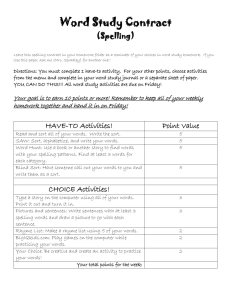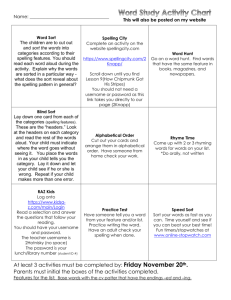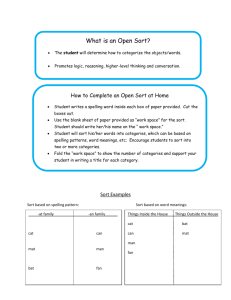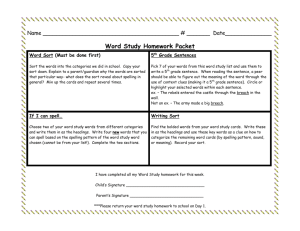Word Study Lesson: Spelling -ABLE &
advertisement
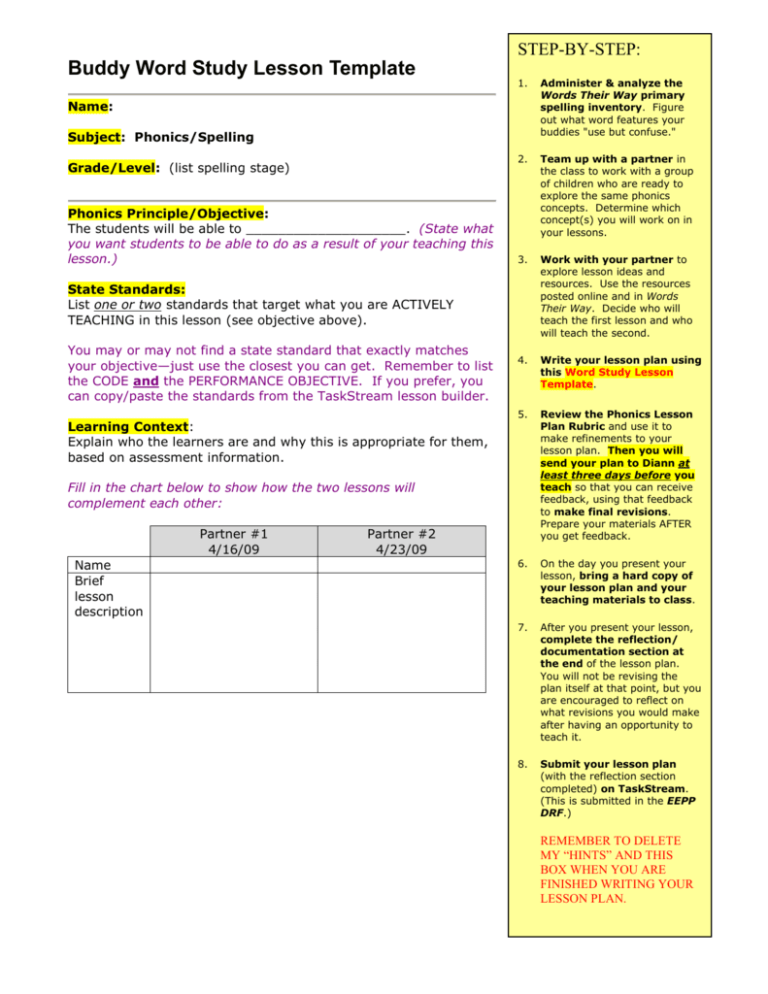
STEP-BY-STEP: Buddy Word Study Lesson Template 1. Administer & analyze the Words Their Way primary spelling inventory. Figure out what word features your buddies "use but confuse." 2. Team up with a partner in the class to work with a group of children who are ready to explore the same phonics concepts. Determine which concept(s) you will work on in your lessons. 3. Work with your partner to explore lesson ideas and resources. Use the resources posted online and in Words Their Way. Decide who will teach the first lesson and who will teach the second. 4. Write your lesson plan using this Word Study Lesson Template. 5. Review the Phonics Lesson Plan Rubric and use it to make refinements to your lesson plan. Then you will send your plan to Diann at least three days before you teach so that you can receive feedback, using that feedback to make final revisions. Prepare your materials AFTER you get feedback. 6. On the day you present your lesson, bring a hard copy of your lesson plan and your teaching materials to class. 7. After you present your lesson, complete the reflection/ documentation section at the end of the lesson plan. You will not be revising the plan itself at that point, but you are encouraged to reflect on what revisions you would make after having an opportunity to teach it. 8. Submit your lesson plan (with the reflection section completed) on TaskStream. (This is submitted in the EEPP DRF.) Name: Subject: Phonics/Spelling Grade/Level: (list spelling stage) Phonics Principle/Objective: The students will be able to ____________________. (State what you want students to be able to do as a result of your teaching this lesson.) State Standards: List one or two standards that target what you are ACTIVELY TEACHING in this lesson (see objective above). You may or may not find a state standard that exactly matches your objective—just use the closest you can get. Remember to list the CODE and the PERFORMANCE OBJECTIVE. If you prefer, you can copy/paste the standards from the TaskStream lesson builder. Learning Context: Explain who the learners are and why this is appropriate for them, based on assessment information. Fill in the chart below to show how the two lessons will complement each other: Partner #1 4/16/09 Name Brief lesson description Partner #2 4/23/09 REMEMBER TO DELETE MY “HINTS” AND THIS BOX WHEN YOU ARE FINISHED WRITING YOUR LESSON PLAN. Spelling Inventory Analysis Charts Copy/Paste the buddies’ spelling inventory feature guides (charts) here. The charts should be right side up and each should be sized to fill about half of the page so that they are easy to read. Be careful about the file size of your scanned images. Materials & Preparation: Make a bulleted list of any materials needed and preparation that should be done before your lesson. Remember, someone else should be able to look at this and know how to recreate your materials. For example, don’t just write “game materials”—be specific. Your materials list should include SORT CARDS. Include a table (see below) that shows the words to be sorted. (If you are doing a picture sort, then list words for the pictures.) Make clear whether you are doing a picture or word sort (or a combination). Add or delete columns and rows as needed. Key Card Key Card Key Card Oddballs* *You don’t necessarily need oddballs in every sort, but it makes sense to include a couple for word sorts if there are important words that seem like they should fit the pattern but don’t (example: the word “said” in a long A pattern sort). If ideas or materials for this lesson came from another source, list it here (text title & author, web address, etc.). Avoid plagiarism by accurately citing any sources and by writing the lesson IN YOUR OWN WORDS (do not copy/paste from others’ lesson plans!). Procedure: Read these reminders and then go to the numbered sections below to actually start writing your plan. Delete reminders when you are finished with your plan. Lesson plans are written as directions, like cookbooks or user manuals. Be sure to include “teacher talk” in bold with quotation marks. Do not script everything, but include the key questions and key explanations you will make. This will help you to think through how to explain things in kid-friendly terms. Bolding it will make it easier to refer to while you are teaching. For clarity, use a capital when you will be saying a letter of the alphabet. Use slash marks // when you will be saying sounds (phonemes). There is a list of phonemes at http://www.public.asu.edu/~diann/Course%20Notes%20&%20Related%20Files/Phoneme%20Categorization%20Table.doc Examples: “I want you to put all of the pictures that have the /ā/ sound under the ‘cape’ card.” “Do you see the letter E at the end of each of these words?” “What are the different ways we can spell long A?” The first four sections of the lesson are for the students to “discover” the concept, to have an “aha” moment as you guide them to discover it for themselves through the sorting activity and discussion. The extension/application section will be an activity or game that allows the students to apply the concept learned in the sort. Link to “real” reading and writing whenever possible so that students can transfer their learning to situations where it will actually be useful. As you write your plan, include the management of materials and other aspects of the learning environment. Consider any special situations with the learners that will impact management, and make plans accordingly. An important rule of thumb about materials: Wait to distribute materials until after you have demonstrated what you want the children to do with them—right before they will use them. Once the kids have the materials in front of them, it can be very difficult to round up their attention again to give instructions. (An exception would be when you have math manipulatives that the kids are not used to. It makes sense to afford time for them to “play” and let the novelty wear off a bit, which will help them focus on learning with the materials during the lesson.) 1. Introduction This is your chance to grab the kids’ attention and would be a good place to use some children’s literature, a poem, song, etc. to ground the lesson in “real” reading (whole to part). You could also share “whole” text later in the lesson, depending on your purposes. Read for meaning and pleasure in addition to making an explicit connection between the book and the concept you are targeting, but don’t spoil the learners’ opportunity to build their own understanding. For example, you might say “I want you to listen for the /ch/ sound in the book while I read and be ready to tell me some words that begin with that sound.” You wouldn’t say “You can see here that the /ch/ sound is spelled CH” because that would spoil their chance to discover that for themselves during the rest of the lesson. 2. Demonstrate the Sort: In this section, describe how you will model the sort. There are many useful picture sort cards and word lists in Words Their Way appendix and on the CD, or you can create your own cards. The site http://www.design215.com/toolbox/wordfind.php is helpful for searching for words with particular letter patterns. In general, choose kid-friendly words in the students’ aural (listening) vocabulary and stick with single-syllable words for basic phonics concepts. When making word cards, be sure not to capitalize unless it is a proper noun (MS Word will try to automatically capitalize as you type). The kids should be able to easily read words used for sorting (kids are able to read many words before they can spell them accurately). Go through the cards and make sure the students know each one—to keep the lesson moving, tell them rather than having them guess. 3. Independent Sorting (or in pairs) and Check: Remember to have the students make columns, not piles, so that the sort can be checked. Check the sort with each student or pair as they finish—specify how you will do that. If you are having the kids sort the cards in more than one way (such as to sort by sound and then by spelling pattern), adjust the lesson plan format as needed to suit your situation. 4. Reflect & Discover: Remember that you hope to have the KIDS notice the pattern(s) rather than coming right out and telling them. List some questions you could ask to help them notice patterns in the sort and make the discovery(ies) you have in mind. Spell out a kid-friendly way of explaining the concept in case the kids do not arrive at the expected conclusion for themselves! 5. Extend & Apply: Provide a chance for the kids to practice/apply the concept they just learned. It could be a game, writing activity (brief and as authentic as possible so it won’t seem like a chore), word hunt, etc. There are lots of good ideas in Words Their Way. NO WORKSHEETS—that is contrary to what we have been learning in this course. This can be a good place to embed an assessment since this activity should require kids to USE what they have learned. Consider the cognitive task being asked of the kids and make sure it matches your phonics principle/objective stated at the beginning of the lesson. 6. Closure: As you wrap up the lesson, re-emphasize the concept the children have learned and model or remind them of ways to use it with their “real” reading and/or writing. Assessment: In this section, describe how will the students’ learning be evaluated. This should help you to determine the students’ progress toward learning what you set out to teach, so make sure the assessment matches the phonics principle of the lesson. Remember, the point of word study is to help kids read & spell better. Your assessment should include reading and/or spelling words with the word feature you are teaching (unless you are focusing on a phonological awareness— “sound”—concept, like rhyming). The assessment may be integrated during the lesson or take place at the end of the lesson. In your lesson plan above, specify when you will assess and how in addition to describing it here. REFLECTIONS & DOCUMENTATION (25% of score) Complete the following AFTER you present the lesson and BEFORE you submit it on TaskStream. Reflections on the Teaching Experience What did you learn about the process of planning and about yourself as a teacher? Look at the results of your assessment--How did your teaching impact the children’s learning? What other observations of their learning did you make? What do you think went especially well with this lesson, and what might you do differently in future teaching situations? Peer Evaluation Your partner will send you feedback via TaskStream or email. Copy and paste it here. Lesson Materials Insert a clear photo of your lesson materials. It is optional, but helpful, to add other electronic materials such as sort cards you created or used, poems used, assessment sheets, scanned student work from the lesson, etc.
